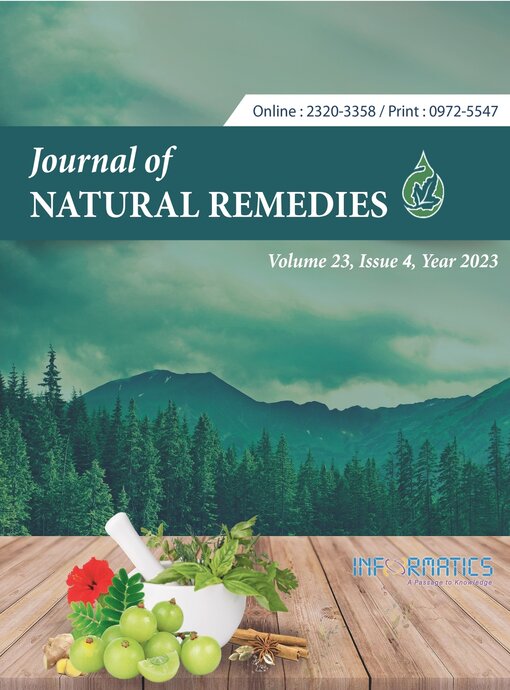Management of Melasma through Ayurveda – A Case Report
DOI:
https://doi.org/10.18311/jnr/2023/33342Keywords:
Ayurvedic, Lepa, Melasma, Nutmeg, Panchanimbadi ChurnaAbstract
Melasma is a pigmentary disorder hyperpigmentation primarily occurring on the cheeks, forehead, and bridge on the nose, upper lip, and occasionally elsewhere on the face. It is painless, superficial brownish macular patches. Modern science recommends laser therapy and various types of steroid use for treating melasma. Laser therapy is very expensive, and steroids have many side effects. So, in this study management of melasma has been done through Ayurveda, which is cost-effective, and easily available with the least side effects. From the signs and symptoms, melasma looks identical to Vyanga as per Ayurvedic texts that come under Kshudraroga (minor disease). In Ayurveda, external therapy Lepa (local application), is prescribed as one of the therapeutic measures for effectively managing melasma. A 32-year-old female patient was diagnosed clinically with melasma. She got treatment from a dermatologist and applied an allopathic care cream over the brownish patches. After regular application of the cream, a brownish patch does not decrease. She has no history of sunray exposure and has no family history. So, she went to Ayurvedic treatment. She was treated with Ayurvedic Lepa for local application and Panchanimbadi Churna internally for 21 days. The content of Ayurvedic Lepa was Nutmeg (Myristica fragrans Houtt.) Churna (powder), and Dugdha (milk). In ancient science, Nutmeg is known by the name of Jatiphala. Nutmeg is a very useful drug utilized therapeutically, and spice and Panchanimbadi are useful in all types of Raktavikara (blood disorders). The result was assessed with subjective and objective parameters, i.e., colour score and MASI score. After 21 days of treatment, significant changes were observed without any side effects. The colour score decreases from 3 to 1, and the MASI score from 15.2 to 10.1.
Downloads
Metrics
Downloads
Published
How to Cite
License
Copyright (c) 2023 Dolly Kumari, Vaishali Chaudhari, Mamata Nakade, Pranesh Gaikwad, Snehalata Pawar (Author)

This work is licensed under a Creative Commons Attribution 4.0 International License.
Accepted 2023-08-24
Published 2023-10-31
References
William JD, Timothy BG, Dirk EM. Andrews’ Disease of the Skin, Clinical Dermatology, 10th edition, chapter 36, Disturbances of Pigmentation, Elsevier Inc All rights reserved, 2006; p. 854.
Rao Badal. A clinical comparative study on vyanga w.s.r to melasma and management with Arjunadi Lepa and Ingudi phala majja Lepa, PG thesis, RUHS Bengaluru Karnataka, Department of Kayachikitsa.
Rook A. Textbook of dermatology, 4th edition, vol. 1, London: Blackwell scientific publication, 1986, p. 670.
Yogaratnakar, edited by Shastri BB, Kshudraroga Chikitsa, 8th edition, Varanasi, Chaukhamba Sanskrit Sansthan, 2004, p. 283.
Murthy KR. Shrikantha, Susurta Samhita, Chikitsa Sthan, Kshudraroga Chikitsa Adhyaya, 20/33, Reprint edition, 2012, Varanasi, Chaukhamba Orientalia, p. 196,197.
Sharma PV. Dravyaguna Vijayanam, volume 2, Reprint 2017, Varanasi, Chaukhamba Bharati Academy, p. 458-460.
Shastri Ambikadatta, Bhaisajyaratnavali, Kshudraroga Chikitsa, Reprint edition, 2015, Varanasi, Chaukhamba Prakashan, p. 950.
Shastri Ambikadatta, Bhaisajyaratnavali, Kustharoga Chikitsa, Reprint edition 2015, Varanasi, Chaukhamba Prakashan, p. 892-893.
Sharma U, Singh P, Saxena GK, Bhora M. Comparative study of the relevance efficacy of kumkumadi cream (with various water and oil phases) for their Vyanga effect. 2017; 8(5):43-8.
Pallavi G, Virupaksha Gupta KL, Shreevathsa M, Vasudev AC, Balakrishna DL. Clinical evaluation of varnya gana Lepa in vyanga (melasma). Clinical Research. 2015; 2(36):151-6.
https://doi.org/10.4103/0974-8520.175543 PMid:27011715 PMCid:PMC4784124 DOI: https://doi.org/10.4103/0974-8520.175543
Sharma PV. Dravyaguna vijayanam, volume 2, Reprint 2018, Varanasi, Chaukhamba Bharati Academy, p. 149, 275, 362, 359, 753, 758, 175, 632, 503, 170, 162, 186, 331, 166, 638, 123, 159.
Cho Y, Kim KH, Shim JS, Hwang JK. Inhibitory effects of macelignan isolated from Myristica fragrans HOUTT. On melanin biosynthesis. Biol Pharm Bull. 2008; 31(5): 986-9.
https://doi.org/10.1248/bpb.31.986 PMid:18451531 DOI: https://doi.org/10.1248/bpb.31.986
Debbarma R, Raghunath GV, Binu MB. A clinical evaluation of Jatiphala churna Lepa in vyanga wsr to melasma. 2020; 8(2):17-26. https://doi.org/10.47070/ijapr.v8iSupply2.1691 DOI: https://doi.org/10.47070/ijapr.v8iSupply2.1691
Kazimierska K, Kalinowska-Lis U. Milk proteinstheir biological activities and use in cosmetics and dermatology. Molecules. 2021; 26(11):3253. https://doi.org/10.3390/molecules26113253 PMid:34071375 PMCid:PMC8197926 DOI: https://doi.org/10.3390/molecules26113253
Murthy KR. Srikantha, Susruta Samhita, Sutra Sthan, Dravadravya Vidhi Adhyaya, 45/50-51, Reprint edition 2012, Varanasi, Chaukhamba Orientalia, p. 335.
Akihisa T, Noto T, Takahashi A, et al. Melanogenesis inhibitory, anti-inflammatory, and chemopreventive effects of limonoids from the seeds of Azadirachta indicia A. Juss. (neem). J Oleo Sci. 2009; 58(11):581-94. https://doi.org/10.5650/jos.58.581 PMid:19844073 DOI: https://doi.org/10.5650/jos.58.581
Alzohairy MA. Therapeutics role of Azadirachta indica (Neem) and their active constituents in disease prevention and treatment. Evid Based Complement Alternat Med. 2016; 2016:7382506. https://doi.org/10.1155/2016/7382506 PMid:27034694 PMCid:PMC4791507 DOI: https://doi.org/10.1155/2016/7382506

 Dolly Kumari
Dolly Kumari









 0.35
0.35 24
24 0.161
0.161